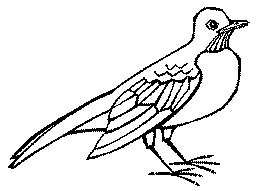


Oh, the joys of spring. Days grow longer, warmed with sunshine. Flowers bloom. And baby birds fall out of their nests like so many drops of rain from an April shower. At Wildlife Rescue, spring and summer are when we're inundated with calls about baby birds who are on the ground-and when we're inundated with the birds themselves, brought to us by kind-hearted citizens who fear for the birds' safety. What many people don't realize is that most of the baby birds they find on terra firma are, by Nature's design, supposed to be there. By "rescuing" them, these people are in fact greatly reducing the birds' chances of survival.
So, how do you tell the difference between a bird who's in danger and one who's just doing what comes naturally? Actually, it's pretty easy.
From a growth standpoint, there are three types of baby birds: hatchlings, nestlings, and fledglings. Very young birds, called hatchlings, have their eyes closed and may be completely naked or have some sparse down-but no feathers. As these birds grow older they become "nestlings." These babies have eyes that are partially open (usually in slits) and their bodies are covered with down, prickly-looking "quills," or some feathers. If you find a hatchling or nestling on the ground, it will need your help. Please put the bird in a small box lined with tissue or dead grass, keep it in a warm, dark, and quiet place, and call Wildlife Rescue immediately for assistance.
If all goes well, nestlings grow up and become fledglings, which have stumpy tails and are fully feathered-but cannot yet fly. If you find a fledgling on the ground, don't pick it up. Fledglings go through a stage when they're learning to fly where they jump or fall out of the nest and live on the ground for several days. Yes, they are vulnerable to certain dangers during this time-especially those of the four-footed variety-but it's natural for fledglings to be on the ground, developing their skills. What's more, they aren't alone. Their parents are still around, feeding them, showing them where to look for food, hiding them under bushes, and fiercely protecting them if they're threatened. The best action you can take if you find a fledgling bird on the ground is to keep dogs, cats, and children away from the area for a few days. If you've already picked up the bird, put it back where you found it or under a nearby bush. And don't worry that the mother will reject it because it smells like a human-that's an old wives' tale. Remember, though: "Over-rescuing" a fledgling turns it into an orphan!
How do you know if it's too late to return the bird? Well, it depends on many factors. The easiest thing to do is to put the bird back and wait around to make sure the parents come back to feed them. Stay far enough away from the fledgling so that the parents aren't afraid to come near. The size and type of the bird will determine how long it can go without food and water, with smaller birds only being able to wait about 2-3 hours. And of course it will also depend on how long ago it had been fed before being "rescued". When in doubt, call your local rehab organization for more information.
Sometimes a fledgling does need help, such as when it's injured or sitting in the middle of a busy street. In that case, keep the bird warm, dark, and quiet and call Wildlife Rescue for assistance.
For more information about nestlings and fledglings, or about Wildlife Rescue, please call the shelter at (650)494-SAVE.
